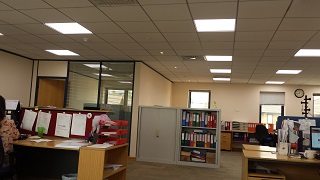From Guest Blogger Ron Robbins: The Sneaky Way You’re Using Energy

How many objects in just your living room are plugged in 24/7 that you use a remote or power on off button when you want to use them or turn them off? Let’s assume you have a television, a Blu-ray player, some sort of gaming system like an Xbox, your cell phone charger, laptop charger and a coffee table lamp. Did you know that these devices are still using power even when you have turned them off. One tip to save electricity and possibly a small amount on your yearly electrical bill is to unplug the cords of electronic items or chargers when they aren’t in use.
According to USA Today, the average household can save about $100 a year by unplugging. This small task can help you save a little money and save a little electricity. Here is a list of items you should unplug in between uses:
- Computers
- Televisions
- Blu Ray Players or Other Video Players
- Modems
- Coffeemakers
- Lamps
- Toasters
- Stereos, Radios, Speakers
- Cordless phones and phone chargers
In addition to unplugging devices here are a few small changes you can make daily to lower your energy usage. While you can’t unplug your refrigerator in between uses, one thing you can do is keep your temperature between 35 to 40 degrees to save on electricity. Wash laundry on either cold or warm, instead of hot to reduce the amount of power your water heater uses. Make sure to replace air filters as recommended to prevent air conditioners from having to overwork.
These small changes can really add up, so remember every little bit counts. Unplug, carpool, buy energy efficient and live green.
— Ron represents Gulf Coast Electric, based in Destin, Florida provides electrical services to the Central Coast.

I used my Kill A Watt EZ, purchased from Home Depot, to measure the power consumption of various devices. For more information on this device, read the instruction manual. Here is the link:
http://www.p3international.com/manuals/p4460_manual.pdf
Calculating the cost of two appliances in $ per month
Cost of power = $0.1373455 per KWH here in Albuquerque, NM
Computer: 28 watts running, 1 watt idle
0.028KW x 24hrs x 30days x $0.137rate = $2.76 per month running, or $33.12 per year.
The cost when in sleep mode $2.76 / 28 = 10 cents per month or $1.18 per year which is too low to be concerned with.
TV: 215 watts running, too low to measure when idle
0.215 x 24 hrs x 30 days x 0.137rate = $19.65 per month running
The meter indicated zero when the TV was turned off with the remote control. Obviously it must have been consuming some power else it would not have been possible to turn it on with the remote control, but apparently the off power was below what the meter could measure. To get an idea of the lowest amount the meter could measure, I plugged an LED night light into it whereupon it indicated 0.3 watts. So, apparently the TV used less than 0.3 watts when off. Conclusion: My TV uses so little power when idle that unplugging it would not be worth the effort since the maximum amount of power it uses when off would cost at most 35 cents per year.
The amount of power devices use when off or idle varies radically. For example, my multi-function machine (printer / scanner/ fax) uses 5.9 watts when idle. That would cost about 58 cents per month $6.95 per year.
I also measured the power used by chargers and found that my cell phone charger, electronic book charger, and camera battery charger, used less power than I could measure when they were idle.
Of course one could add up all the devices in one’s house to determine the total amount per year one could save by unplugging things, which I have not done. One would have to consider the inconvenience compared with the amount saved.
I don’t remember how much the meter costs, but it was not particularly expensive considering its capabilities. It can be left connected to an appliance, such as a refrigerator, to measure the total amount of power it uses while connected and how much that power would cost. It can do that because it permits keying in the cost of power per KWH. It measures current in amperes, power factor, KWH, and KVA.
Obviously one can save money by using cold water to do the laundry. However, some health authorities see that as unwise. It is also possible to save money by setting the water heater temperature to no more than 120F. However, when doing that, some health authorities recommend raising the temperature to more than 140F once per week to kill bacteria which can live and grow at 120, especially the bacteria which causes Legionnaire’s disease.
Energy saving recommendations vary depending on which authorities make them. For example, some environmentalists assert that outside lighting at night does not deter malefactors while the police and others concerned with crime recommend outside lighting.
One must use one’s own judgment rather than blindly following recommendations.
Using a solar clothes dryer, (clothes line) and then put stiff towels in the dryer for 5 minutes to soften them.
Door bell
Use a solar task light
Garage opener
Use occupancy sensors for lights and bath fans.
AlabamaEnergyDoctors.com
Using a solar clothes dryer, i.e., a clothes line, could save considerable power. Unfortunately, for many people, that is impossible.
Bathroom fans should be timer controlled to make it impossible to turn them off. I would not want an occupancy sensor on one; they have to be run for some time after bathing.
The other items actually use only trivial amounts of power.